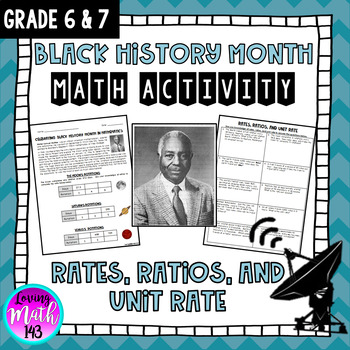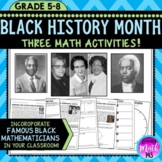Walter McAfee: Black History Month Math Activity (Ratios and Proportions)
- PDF
- Easel Activity
What educators are saying
Also included in
- Get ALL THREE of my Black History Month Activities:1. Walter McAfee: Black History Month Math Activity (Ratios & Proportions)This is a math activity celebrating Black History Month. The activity gives a brief description of Walter McAfee. McAfee has been credited for calculating the distance frPrice $9.00Original Price $11.50Save $2.50
- Black History Month: FOUR Math Activities Bundle!Get ALL FOUR of my Black History Month Activities: *including KOBE BRYANT*1. Hidden Figures: Math Activity (Evaluating ExpressionsThe activity gives a brief description of the three brilliant African-American women at NASA -- Katherine Johnson, DorothPrice $12.00Original Price $15.00Save $3.00
Description
Walter McAfee: Black History Month Math Activity (Ratios & Proportions)
This is a math activity celebrating Black History Month. The activity gives a brief description of Walter McAfee. McAfee has been credited for calculating the distance from the earth to the moon using radar technology.
Students will then answer 13 questions about outer space including the moon, and the planets in our solar system. Each question is aligned with the 6th grade common core standards about rates, ratios, ratio tables, and unit rate. The activity has a planet theme relating back to McAfee and his discovery about the moon. This activity is a great way to recognize and celebrate Black History Month in your math classroom!
***********************************************************************************************
HOW TO USE:
No prep necessary! Simply copy the math activity for each student. Read through the history of Walter McAfee as a class then discuss the expectations of the activity. Students will then answer 13 questions using ratios, rates, ratio tables, and unit rate. Answer Key included.
***********************************************************************************************
WHATS INCLUDED:
★ History of Walter McAfee
★ 3 questions about planet rotations using ratio tables (scaling)
★ 10 Questions about time, space, and distance using rates and unit rate.
★ Answer Key included.
YOU MAY ALSO LIKE:
★ Ratio, Ratio Table, and Unit Rate Anchor Charts
★ Benjamin Banneker: Black History Month Math Project
★ Combining Like Terms: Color By Number Activity (Perfect for Valentine's Day)
★ Valentine's Day: The Distributive Property - Solve & Color
***********************************************************************************************
LICENSING TERMS: This purchase includes a license for one teacher only for personal use in their classroom. Licenses are non-transferable, meaning they can not be passed from one teacher to another. No part of this resource is to be shared with colleagues or used by an entire grade level, school, or district without purchasing the proper number of licenses.
COPYRIGHT TERMS: This resource may not be uploaded to the internet in any form, including classroom/personal websites or network drives, unless the site is password protected and can only be accessed by students.





